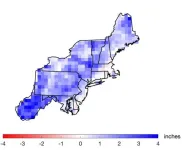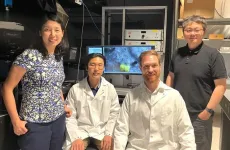(Press-News.org) Less than two percent of the human genome codes for proteins, with the rest being noncoding and likely helping with gene regulation. Mutations in the noncoding genome often trigger trait changes that cause disease or disability by altering gene expression. However, it can be hard for scientists to track down which of numerous variants associated with a disease or other complex trait are the causal ones and to understand the mechanism of their effects. Researchers at the Brigham developed a new computational approach that hones in on small regions of the noncoding genome that genome-wide association studies (GWAS) identified as being correlated with changes to blood cell traits, including lowered lymphocyte counts and hemoglobin concentrations. They then scanned these regions for specific mutations that caused a transcription factor protein, called PU.1, to bind to certain areas more or less strongly than normal, and examined the effect that such mutations had on PU.1’s binding site. Their method uncovered 69 mutations that affected PU.1 binding and were related to quantitative differences in blood cell trait changes, 51 of which altered PU.1’s binding site and thus likely caused a physiological difference.
“Our method could be applied to better understand a range of genetic conditions and to help pinpoint the causal variants in the noncoding genome underlying various biomedical traits,” said senior author Martha Bulyk, PhD, a Principal Investigator in the Brigham’s Division of Genetics. “Here, we identified noncoding variants that appear to contribute to quantitative differences in blood cell trait changes. This approach could be used to uncover the transcriptional regulatory mechanisms hidden in the GWAS data of other complex traits.”
in Cell Genomics.
END
Computational method uncovers the effects of mutations in the noncoding genome
2023-05-30
ELSE PRESS RELEASES FROM THIS DATE:
Extreme precipitation in northeast to increase 52% by the end of the century
2023-05-30
With a warmer climate creating more humid conditions in the Northeast, extreme precipitation events — defined as about 1.5 or more inches of heavy rainfall or melted snowfall in a day — are projected to increase in the Northeast by 52% by the end of the century, according to a new Dartmouth study.
The findings are published in Climatic Change.
"As climate change brings warmer temperatures, you have more water vapor in the atmosphere, which creates the right conditions for extreme precipitation," says first author Christopher J. Picard '23, an earth sciences major and undergraduate researcher in the Applied Hydroclimatology Group ...
Lung infection may be less transmissible than thought
2023-05-30
A little-known bacterium — a distant cousin of the microbes that cause tuberculosis and leprosy — is emerging as a public health threat capable of causing severe lung infections among vulnerable populations, those with compromised immunity or reduced lung function.
Recent research found that various strains of the bacterium, Mycobacterium abscessus, were genetically similar, stoking fears that it was spreading from person to person.
But a new study by Harvard Medical School researchers published ...
Experimental decoy protects against SARS-CoV-2 infection
2023-05-30
An experimental “decoy” provided long-term protection from infection by the pandemic virus in mice, a new study finds.
Led by researchers at NYU Grossman School of Medicine, the work is based on how the virus that causes COVID-19, SARS-CoV-2, uses its spike protein to attach to a protein on the surface of the cells that line human lungs. Once attached to this cell surface protein, called angiotensin converting enzyme 2 (ACE2), the virus spike pulls the cell close, enabling the virus to enter the cell and hijack its machinery to make viral copies.
Earlier in the pandemic, pharmaceutical ...
Light conveyed by the signal transmitting molecule sucrose controls growth of plant roots
2023-05-30
Plant growth is driven by light and supplied with energy through photosynthesis by green leaves. It is the same for roots that grow in the dark – they receive the products of photosynthesis, in particular sucrose, i.e. sugar, via the central transportation pathways of phloem. Dr. Stefan Kircher and Prof. Dr. Peter Schopfer from the University of Freiburg’s Faculty of Biology have now shown in experiments using the model plant Arabidopsis thaliana (thale cress) that the sucrose not only guarantees the supply of carbohydrates to the roots, it also acts as a signal transmitter for ...
Mitigating climate change through restoration of coastal ecosystems
2023-05-30
One of the primary drivers of climate change is excess greenhouse gases like carbon dioxide in the atmosphere. Mitigating climate change in the coming century will require both decarbonization — electrifying the power grid or reducing fossil fuel-guzzling transportation — and removing already existing carbon dioxide from the atmosphere, a process called carbon dioxide removal.
Researchers at the Georgia Institute of Technology and Yale University are proposing a novel pathway through which coastal ecosystem restoration can permanently capture carbon dioxide from the atmosphere. Seagrass and mangroves — known as blue carbon ecosystems — naturally capture ...
Flexible nanoelectrodes can provide fine-grained brain stimulation
2023-05-30
HOUSTON – (May 30, 2023) – Conventional implantable medical devices designed for brain stimulation are often too rigid and bulky for what is one of the body’s softest and most delicate tissues.
To address the problem, Rice University engineers have developed minimally invasive, ultraflexible nanoelectrodes that could serve as an implanted platform for administering long-term, high-resolution stimulation therapy.
According to a study published in Cell Reports, the tiny implantable devices formed stable, long-lasting and seamless tissue-electrode ...
Teens with irregular sleep patterns have higher risk of school problems
2023-05-30
DARIEN, IL – A new study to be presented at SLEEP 2023 found that teens with greater variability in their sleep patterns have a higher risk for school-related problems.
Results show that the teens with greater night-to-night variability in the time they fell asleep were 42% more likely to have been suspended or expelled in the past two years, 29% more likely to have received a D or F in any course, and 26% more likely to have ever failed a course. The likelihood of suspension or expulsion was also 31% higher in teens with greater variability in sleep duration.
“Variability in sleep duration and later sleep ...
Genetic risk information may help people avoid alcohol addiction
2023-05-30
Today’s substance use prevention efforts ignore individual genetic risk, but Rutgers research suggests DNA test results may eventually enhance prevention and treatment and improve outcomes.
Investigators recruited 325 college students, provided them with varying levels of information about alcohol use disorder and how genetics affect addiction risk and asked them how they would react to learning they had high, medium and low genetic tendencies toward alcoholism.
The results provided two significant supports for eventually using real genetic risk scores in actual addiction prevention efforts. First, participants understood what those scores indicated; they recognized that higher ...
Advances in technology are driving popularity of EVs
2023-05-30
Transportation accounts for roughly one-third of U.S. greenhouse gas emissions, and adoption of electric vehicles are seen by many experts in government and the private sector as a vital tool in efforts to reduce carbon emissions. Roughly a decade ago, EVs accounted for a tiny fraction of overall car sales. As of March 2023, they make up 7% of new sales
“What changed between then and now?” asks Kenneth Gillingham, professor of environmental and energy economics at the Yale School of the Environment. ...
Newborns with higher hair cortisol levels take longer to fall asleep
2023-05-30
DARIEN, IL – Cortisol levels in late pregnancy can predict the sleep of infants, according to a new study to be presented at the SLEEP 2023 annual meeting.
Results show that newborns with higher levels of cortisol in their hair samples took longer to fall asleep at 7 months of age. Neonatal hair cortisol is a measure of fetal cortisol in the last trimester of pregnancy.
“Although increases in cortisol across pregnancy are normal and important for preparing the fetus for birth, our findings ...

